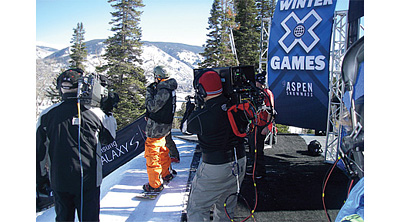ESPN Brings 'Optimum Visual Experience' to Winter X Games
ASPEN, COLO.—If you watch ESPN's Winter X Games Aspen 2012 in HD, Jan. 26-29, you will only be getting half the picture. This is because ESPN is showing the entire event in 3D.
In fact, the HD/2D feeds will be one half of this network's twin-camera 3D feeds. In this way, ESPN will serve both markets of viewers, just as it served HD and SD viewers during its original HD rollout by downconverting HD feeds to SD.

For the 2012 Winter X Games, ES PN will deploy a mix of Sony cameras configured for 3D using Cameron Pace Group 3D rigs. "Last year, we ran side-by-side 3D and 2D operations," said Phil Orlins, ESPN's X Games coordinating producer. "But no more. With more than 170 3D telecasts under our belt, we feel pretty comfortable with 3D technology. So we're ready to go all-out 3D this year."
"Technically, it stretches us a little beyond where we've been before," adds Stephen Raymond, associate director of ESPN Event Operations. "But we have a well-trained crew who are used to implementing whatever designs they have to deal with."
3D SETUP
As has been the case at previous 3D telecasts, ESPN's 2012 Winter X Games coverage is being produced using NEP's Super Shooter 32 (SS32) mobile unit, comprised of two 3 Gbps-capable trailers. The A Unit is a single expando 53-foot trailer that houses a full production room featuring a Sony MVS8000-X video switcher, EVS XT3 video servers, Calrec Alpha Bluefin audio mixer and Evertz EQX router. The B unit is a 48-foot trailer with room for up to 14 convergence operators and a stereographer. Both have been built specifically 3D production. To provide extra production capacity, ESPN will also deploy NEP's Super Shooter 21 (A, B and C units) working in tandem with a CPG Shadow unit.
"For the 2012 Winter X Games, we will be using a mix of Sony cameras configured for 3D using Cameron Pace Group 3D rigs," says Orlins. "We will have four 'nano beam splitters', which are really pairs of tiny Sony PMD10 cameras set up in a handheld configuration." ESPN will also have 10 pairs of Sony HDCP1 cameras set up in robotically controlled positions that will be housed in weatherproofed heated shells, to protect them and their 3D rigs against the cold.
"Additionally, pairs of HDCP1s will be used on our five jibs, aerial FlyCam and two Strada cranes," Orlins said. "Finally, we will be using two pairs of Sony HDC1500s with Fujinon 42x zoom lenses for distance shots." The cameras will be set up across Buttermilk Mountain, the site of the Winter X Games' site in Aspen.
"The biggest challenge is putting our hands on all the 3D rigs we need," notes Raymond. "The second is locating the mobile production infrastructure that will support 3D production. That extends from having proper monitoring and playback devices to switcher and router capacity."
IMMERSED AND IN PERSON
Despite the fact that ESPN is committed to an all-3D 2012 Winter X Games, some Sony HDC-1500 2D cameras will be tasked from SS21 to supplement its 3D camera coverage.
"The truth is that 3D cameras have their limits; particularly when it comes to shooting action at great distances using telephoto lenses," Orlins tells TV Technology. "Add the fact that telephoto 3D wide shots do not have the depth of field provided by close shots—and it makes sense to use whatever equipment is best for the job—which sometimes means 2D."
ESPN's extensive experience in 3D has changed how the network produces such events. "In the early days, the idea was to deliver an 'all-3D experience' to the viewer," Orlins said. "But now we've refined our approach to producing what we call the 'Optimum Visual Experience.'" In this new model, the goal is to make viewers feel as if they are actually at the event, without having athletes jump into their faces.
This is why ESPN can see a place for 2D in its 3D production plans; particularly for distance shots where depth of field isn't that noticeable, but clarity is. "It is very difficult to balance a pair of cameras in 3D mode on telephoto, and even when we do, the viewer often can't see the difference," Orlins says. "So we decided to deliver a better visual experience by using 2D where it makes sense. At distances where the subject is often well beyond 100 feet the viewer likely won't notice the difference in depth of field, but they will appreciate the vivid tight shots that they have come to expect from televised sports coverage."
Does ESPN's adoption of the 'Optimum Viewing Experience' mean an end to "in-your-face 3D?" Not at all, Orlins said. "We know that people who watch 3DTV want excitement, and demand coverage that is anything but bland. So we will still be delivering that 'wow factor' in our coverage. But our aim is to make you feel immersed and in person at the Winter X Games; not at constant risk of personal injury."
In fact, ESPN's "Optimum Viewing Experience" signals the network's maturity as a 3D content producer. They have moved past 3D as a novelty, to embrace it as a more effective way of delivering compelling sports programming.
So when it makes sense, you can expect athletes at the Winter X Games to be barreling into your face. It just won't happen every single second of every single broadcast.
The professional video industry's #1 source for news, trends and product and tech information. Sign up below.
James Careless is an award-winning journalist who has written for TV Technology since the 1990s. He has covered HDTV from the days of the six competing HDTV formats that led to the 1993 Grand Alliance, and onwards through ATSC 3.0 and OTT. He also writes for Radio World, along with other publications in aerospace, defense, public safety, streaming media, plus the amusement park industry for something different.

